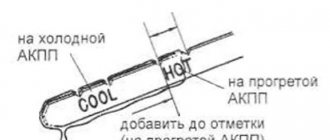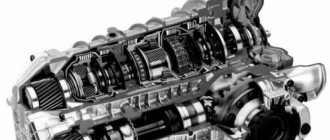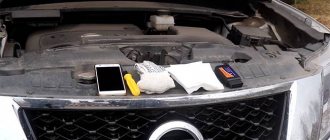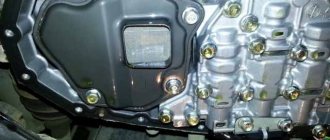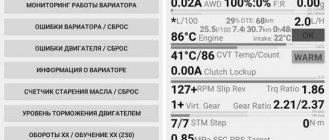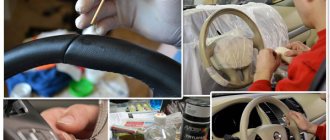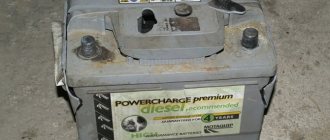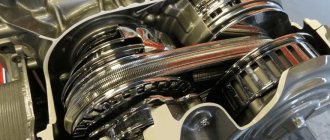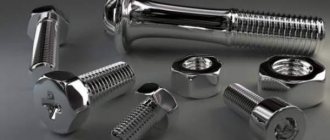The CVT on the Toyota Corolla, according to reviews from owners, is a reliable unit only if the operating rules are followed. The transmission simplifies the process of driving a car and does not require manual gear shifting. By smoothly adjusting the gear ratio, fuel consumption is reduced regardless of the driving mode.
The Toyota Corolla CVT is a reliable unit.
The concept of a variator
The variator allows you to smoothly change the gear ratio, acceleration and deceleration occur without jerking. The design does not have a pedal-driven clutch; a hydraulic transformer is used to open the engine crankshaft and the primary axis of the box.
The Toyota Corolla uses units manufactured by Aisin, the model depends on the year of manufacture of the car.
Design and principle of operation
The design of the unit includes 2 conical surfaces located on the drive and driven shafts. Torque is transmitted by a metal plate belt, which is constantly lubricated with special oil. The electronic control unit automatically adjusts the position of the belt on the cones, smoothly changing the gear ratio. Wear products entering the oil are captured by a filter and a magnetic plug in the gearbox housing.
Basic faults
Below we will look at what breakdowns are typical for Toyota Corolla variator transmissions of 2014, 2015, 2016, 2022 and other model years and what needs to be done to repair the unit.
User Azat Ahmet encountered a problem with the noisy operation of the variator and recorded it on video.
Troubleshooting
Most transmission problems can only be detected through computer diagnostics.
Malfunctions that will lead to transmission repair:
- Broken drive belt. Over time, the V-strap begins to wear out. Its wear will be faster if the car owner does not follow operating rules and regularly drives at high speeds or off-road. Due to rapid wear, the belt breaks. Its links can fly throughout the transmission and damage other transmission components.
- Malfunctions in the operation of the control module. Usually the control unit works without interruption, but sometimes it starts to act up or fails altogether. A module failure will require its replacement. Finding a qualified CVT repair specialist today is difficult. Therefore, service station technicians usually simply change the module. The unit can be reflashed or the board can be repaired if its failure is caused by clogging or moisture. But flashing will require special equipment and software.
- Failure of support bearings. These devices are subject to high loads, especially when operating in harsh conditions or when there is a lack of lubricating fluid in the transmission. Bearings become unusable over time, and their wear products in the form of metal shavings can fall on other parts and clog the channels of the oil system. If this happens, the pressure in the system begins to increase, which can lead to its premature failure or squeezing out the seals.
- Failure of the speed controllers of the drive and driven shafts. The lubricant temperature sensor and the oil pressure in the main line or shafts are also susceptible to malfunctions. To fix the problem, you will need to dismantle the unit. Often the reason for the non-working state of sensors is damage to the contacts on their connectors or a break in the wiring. Sometimes the contacts become dirty, which causes the controller to not work correctly. It is necessary to diagnose the integrity of the connectors and “ring” the wiring. If the wires and contacts are intact, then the sensors must be replaced.
- Malfunctions in the operation of a hydraulic transformer are determined through detailed diagnostics of the device. If this unit fails, you can try to repair it by replacing the broken parts. But usually the entire device assembly must be replaced. Finding it on sale can be problematic.
- Reducing valve failure. This malfunction manifests itself in the form of jerks and jerks of the vehicle. The valve begins to operate when the power unit starts. The pumping device in Corolla CVTs is a non-separable unit. Therefore, if the valve fails, the mechanism must be replaced. During normal operation of the valve, the device moves freely along the sleeve, which is installed in the body of the pumping device. As a result of the constant interaction of the working surface of the part with various particles and deposits that are present in the oil, the valve wears out.
- If, when you try to move, the car does not move or moves, but its dynamics are too weak, it is necessary to diagnose the main clutch, as well as the CVT transmission itself. The reason may be a malfunction in the torque converter device, or less commonly, a non-working control unit.
- A malfunction of the main line pressure solenoid valve will cause the vehicle to move jerkily. And when you shift from neutral to D, you will feel a distinct jolt. The valve must be replaced.
- If you put your car in neutral and it continues to roll, there could be several reasons. First you need to check the operation of the gear shift lever, as well as the control module. The cause of the problem may be damage to the electrical circuit or connectors on the sensors. All devices must be checked.
The CorollaFielder channel has provided a video from which you can find out what a CVT transmission pan looks like after 130 thousand kilometers.
Main types of CVT
CVTs used on cars are divided into types depending on the method of torque transmission:
- steel belt with a wedge-shaped profile or chain;
- rollers (adjustment of the gear ratio is achieved by changing the angle of installation of the disks).
Clinomeric
The classic variator provides for the transmission of torque due to the friction force between the belt and conical surfaces. The design can be equipped with a planetary gear, which prevents the belt from reaching the end edges of the cones. The unit is compact in size and light in weight; manual shifting of fixed gears is possible.
The clinometer variator has compact dimensions.
Toroidal
The design has a driving and driven disks, between which there are rollers with the ability to change the axis angle.
Depending on the position, the gear ratio changes. Toyota cars do not use a toroidal variator.
Technical features of Direct Shift-CVT
The new generation Toyota CVT K120 was presented in 2022. For the first time, a continuously variable transmission of this series was installed on the Toyota RAV4 50 and Corolla 210.
The main innovative solution was the introduction of launch gear.
As a result, the classic variator (moving pulleys connected by a metal belt) was supplemented with a gear mechanism. It comes into operation, directly cutting off the variator, when driving at low speed, in reverse and when starting from a standstill. This made it possible to transfer the most unfavorable operating modes for the V-belt continuously variable transmission to the starting gear . The fact is that when in the extreme position, the belt operates along a minimum radius with a maximum bend. There is also the smallest area of contact with the drive pulley, which is accompanied by slippage and tension movement.
Compared to the range of gear ratios of the Toyota K120 variator with previous generations, it has increased - 7.5 instead of 6-6.5. But in fact, the range of the continuously variable transmission itself has decreased to 5.0, which makes the belt's work easier.
There is also a decrease in the diameter of the pulleys and the camber angle between them (from 11 to 9 degrees). This made it possible to increase the speed of change of the gear ratio.
Advantages and disadvantages
Advantages of the variator noted by owners:
- smooth change in torque;
- reduced fuel consumption due to the optimal ratio of load and crankshaft speed;
- ease of driving.
Disadvantages indicated in reviews:
- the need for regular maintenance with replacement of fluid and filters;
- belt life does not exceed 150 thousand km;
- labor-intensive and expensive repairs;
- in case of breakdown, the car is immobilized;
- The unit is not designed to work with a trailer and quickly breaks down when slipping in snow or mud.
Toyota models with continuously variable transmission
The Toyota concern began using CVTs in 2000 on Opa cars, which were supplied to the Japanese domestic market. In Europe and North America, cars with CVT appeared only in 2009. The first were Avensis and Verso, equipped with a unified K311 unit with different control units. A year later, the experiment was extended to RAV4 crossovers with front-wheel drive or all-wheel drive. Toyota Corolla began to be equipped with a CVT only in 2013. The type of transmission can be determined by the text on the identification sticker, which contains information about the transmission model.
Since 2000, Toyota models have been produced with a continuously variable transmission.
Similar, but not the same
The solution used by Toyota brings to mind the Jatco CVT7 (JF015E) variator, which has been in production for almost 10 years, since July 2009 - this is the world's first variator with a mechanical two-stage gearbox. However, JATCO has supplied the CVT and gearbox in series, and torque is always transmitted through one of the gear pairs and the CVT. And in Direct Shift-CVT, the gear pair and the variator are used, so to speak, alternately in parallel - the moment is transmitted either by the gear pair or by the belt on the pulleys.
Insert video:
How does the Jatco CVT7 variator work?
Features of operation and maintenance
During operation, it is necessary to monitor the level and condition of the working fluid. Steel chips in the oil will accelerate wear on the cones and metal belt. Prolonged movement at maximum speed, which leads to overheating of the transmission, is not allowed. The driver needs to smoothly pick up and slow down, avoiding slipping. Before starting to drive, the variator should be warmed up with the car standing and the engine running at idle speed. Do not tow trailers or other vehicles to a CVT-equipped Corolla.
The variator is serviced with fresh fluid refilled after 70-80 thousand km of travel. Some owners try to carry out the procedure 2 times more often, ensuring timely removal of wear products. When servicing, it is necessary to install a new filter (original parts are not supplied for all types of gearboxes), a pan gasket and a drain plug ring.
When draining the crankcase, no more than 80% of the liquid leaves, so you will have to fill and pump out the oil at least 2-3 times in a row.
Frequent malfunctions and repairs
When the working surfaces wear out, the friction coefficient decreases, the car accelerates jerkily, and when the speed is reduced, the engine may stall. In this case, it is necessary to assess the condition of the working fluid. Blackening of the oil and metal inclusions indicate damage to parts. To restore functionality, you will have to disassemble the unit.
Adding fresh fluid can delay repairs for several weeks or months. The burning smell emanating from the oil indicates the need to stop using the variator, which is in disrepair.
The most loaded parts are the rotor bearings. When damaged, a hum occurs, the tonality depends on the speed of movement. Some owners encounter this after 50-60 thousand kilometers. The problem occurs due to metal shavings getting under the rolling elements or due to unstable quality of components at the factory. Fans of sharp acceleration complain that scuff marks form on the cones. In this case, the functionality of the box can only be restored by installing new parts.
CVT for Toyota Corolla: reviews from owners, reliability of a continuously variable transmission
It’s just that in this mode there is no engine braking as is the case with manual transmissions or classic automatic transmissions.
TO TAKE OR NOT TO TAKE A CAR WITH A CVT ALL THE PROS AND CONS OF A CVT
My Corolla from the year it was produced has already driven thousands of cars, and at the service station, when passing the technical inspection, the technicians looked at me with round eyes - the oil was the purest.
That is, the larger the size difference, the higher the CVT performance becomes. In general, I had to leave the car at the dealer, they said that when the part arrived, we would immediately replace it. Igor, driving experience - 5 years. My old lady is from the same year, and I’m glad that I fell for the seller’s persuasion about the variator.
The traction appears after seconds if you do not press the accelerator.
As for spare parts, you won’t find the original anywhere! Brake pads cost five thousand rubles 1 hryvnia per set, but the originals are not available in any store!
The suspension leaves much to be desired, but the CVT is a separate issue altogether. It can quite easily become dull in a traffic jam, especially when crossing a traffic light on a flashing yellow one. Again, I went to the dealer - there the manager looked and said: Like, when it breaks down, then come, or rather, come with a tow truck.
I drive a Toyota Corolla, I bought a new one last year and took it from the dealership. Before purchasing, I read a lot of negative reviews about this car model and the CVT transmission in particular.
Maybe I’m not used to such cars, or my requirements are too low, but the CVT is something! Previously, I once drove a friend’s X-Trail, so his two-liter engine is not as playful as my 1.6-liter engine. Or maybe it's the variator. In general, I’m skating and I can’t get enough of it.
Toyota Corolla 2013, petrol engine 1.6 l., 122 l. p., front drive, CVT — observation
I travel a lot, I’ve already covered more than a thousand kilometers in a year, as I travel all over the country. I went to the official dealer, saying I needed to change the oil. They sent me to their service station, where the technicians opened the box to look, and the oil there was pure! No metal shavings or other wear products, as if it had just been poured!
Therefore, we decided not to do a complete flush of the system, but filled in 4 liters.
9 users said thank you:
It's not too expensive for the money, I have fun riding! I shouldn't have bought this car! Now I’ll explain what’s what. Our road to the city, to put it mildly, is not very good. Of course, the speeds were not changed. We went to the dealer, where a guy climbed into the box and started looking and said that the belt had broken. Yes, yes, that same fucking steel belt!
Because Corollas must be driven on a flat paved road. In general, I had to leave the car at the dealer, they said that when the part arrived, we would immediately replace it. At first they said to wait about a week or two.
As a result, I waited almost a month and a half, but the repairs were still done free of charge. I've only driven one and a half thousand kilometers since I've only had the car for a week. In general, I’ll say this - I’m overall pleased with the purchase. I compare it with the previous car - Mitsushibi Lancer.
These are two fundamentally different cars - Lancer is a more aggressive car, and Corolla is calmer and more balanced. Actually, it was on the track that I learned all the capabilities and features of the CVT. It feels like real professionals worked on the gearbox. No delays when switching gears, everything works quickly, like clockwork!
Another feature that manifests itself during intensive overtaking is the freezing of high engine speeds immediately upon completion of overtaking.
I often notice this when I sharply overtake and wedge into traffic, braking to the speed of the flow - the engine speed remains elevated, despite the fact that I do not press the accelerator at all.
The intensive overtaking program is activated and the gearbox holds the speed so that the driver can continue overtaking.
If you lightly press the accelerator and hold it, the speed will drop to nominal after seconds. Our gearbox also allows you to use a mode such as engine braking, for example, during a long descent from a mountain.
This is perfectly implemented in M mode. We lower the gears, and voila - the car slows down without using the brake. If you want to roll down a hill in “neutral”, then turning on N mode is not necessary and not advisable; the box itself maintains neutral in D mode without pressing the gas.
It’s just that in this mode there is no engine braking as is the case with manual transmissions or classic automatic transmissions. In winter, when starting to move, the gearbox maintains higher engine speeds - this is due to the fact that it warms up so much.
Toyota Corolla 2013, used car with warranty! (On sale at RDM-Import)
It can also increase engine speed even when the engine is warm, if the temperature is so low that the oil in the box cools below operating temperature while driving. Actually, that's all I have to say at the moment about our box.
If I remember anything, I’ll add it.
Among other operational advantages, as evidenced by reviews from owners of cars of this model, from 2015 to the present year, one can note high dynamism and rapid acceleration without jerking, and a high ability to move away without slipping.
Is the CVT reliable on Toyota Corolla?
The reliability of the variator directly depends on the management style and the frequency of maintenance. There have been cases where the box has withstood a mileage of more than 200 thousand km without replacing parts. When purchasing a new car, the transmission is covered by a manufacturer's warranty, which is obliged to correct all damage caused by defective parts. When choosing a used Corolla with a CVT, you should diagnose the transmission and evaluate the condition of the unit. On the spare parts market there are units removed from broken cars, so there will be no problems with repairs.
CVT potential in terms of resource
According to established tradition, Toyota specialists were developing this unit together with colleagues from Aisin. This CVT has already been equipped with the Toyota Corolla Hatchback in the fall of 2022; the car is intended for the American market. As for Russian buyers, anyone who wants to purchase a vehicle with Direct Shift-CVT today can count on purchasing a fifth-generation Toyota RAV4 XA50 with this transmission.
Since Direct Shift-CVT has not been in business for very long, we can draw the first cautious conclusions. The variator did not turn out to be ideal; there were several “childhood diseases” that the manufacturer had to promptly treat. It turned out that this unit has a rather weak and sensitive torque converter. Just a few months after the sale of the first Toyota copies, all cars with this variator were recalled to replace the unit with a similar one, but with a different gas turbine engine. Since the new gearbox is still in short supply, the car recall campaign is still ongoing.
Another problem area is solenoids. They are sensitive to the quality and purity of gear oil. This means that you will have to change the gear oil in Direct Shift-CVT as often as possible. But a positive point can be taken from all this - the technological transmission reached Russia after a thorough test in real conditions. That is, the end buyer will be able to purchase a car with a CVT variator that is already reliable and free of any shortcomings. Expected resource – 300 thousand km. But again, a lot depends on the service.
CVT Direct Shift-CVT
CVT Direct Shift-CVT
edit this post
Owner reviews
Owners of Toyota Corolla with a CVT leave different reviews about the service life and characteristics of the transmission. The opinion is influenced by the mode of operation, total mileage and frequency of maintenance of the box. If the owner likes sharp acceleration and driving at high speed, then the CVT will fail after 20-30 thousand km. Calm drivers can use their car for years without complaining about CVT breakdowns.
Positive
Oleg, 28 years old, Tver
I drive a Corolla with a 1.6-liter engine, released in 2022. The car has covered 82 thousand km, 70% of the mileage was on the highway. Speed up to 140 km/h, I rarely use sport mode. There were no jerks during operation; the control unit firmware was factory installed.
Nikolay, 55 years old, Omsk
I am the owner of a Corolla with a CVT and a 1.8 liter engine. I changed the oil in the gearbox for the first time when the mileage was 110 thousand km, the service was carried out at the dealer at a special stand. The drained liquid was clear and did not contain chips. I drive calmly, the speed on the highway is about 100-110 km/h. I warm up the box for 1-2 minutes in summer and 5-7 minutes in cold weather.
Negative
Mikhail, 31 years old, St. Petersburg
I bought a car with a 1.6-liter engine in 2015. At 50 thousand km, a whistling sound from the variator appeared; when switching modes, the tone of the noise changed. The dealer ran diagnostics and found no faults. I sold the car with 80 thousand km mileage, informing the buyer about the potential problem.
Let's talk about the CVT variator — logbook Toyota Corolla 2013 on DRIVE2
Well, it's time to talk about the Corolla Multidrive S variator.
I’ll tell you about my feelings, observations and comments. For the average user, in principle, there cannot be any special features - an ordinary automatic transmission. But over time, some features stand out that either frighten the owner or are annoying.
And if you previously owned a car with a conventional torque converter or robotic gearbox, then there are more questions. I won’t go into the intricacies of the device (there’s plenty of information on the Internet), I’ll only tell you about the noticeable features in the control.
Let me start with the fact that the CVT is a continuously variable automatic transmission, but, in our case, it has 7 virtual gears. This gives us the feeling that the transmission is a seven-speed torque converter. We can also control these gears in “M” mode. Speaking of modes, the box has standard automatic transmission modes: P, R, N, D and M.
Modes P and N are identical, but in mode P the gearbox output shaft is purely mechanically locked from turning. In these modes the car can be started, in others it is not. In addition to the standard modes, there is a SPORT mode, which is activated by the corresponding button next to the gearbox selector.
It allows the engine to spin until the cut-off point. This mode is very convenient when overtaking on the highway - it allows you to use the full potential of the engine. Let's go.
I started the car, pressed the brake pedal, switched the selector to mode D and did not release the brake pedal immediately, but only after 2-3 seconds, allowing the box to turn on completely, since it does not switch instantly. If you release the brake pedal immediately after turning on the mode, you can feel a significant push, as if the car was pushed strongly from behind. This push does not bring anything good to the box.
By the way, there is one significant feature - if you press the accelerator pedal hard when the car is on a slippery road surface, then the following situation will occur - the engine will increase speed, the drive wheels will slip into the axle box and the gearbox will immediately reduce the traction force to zero, while the engine will respond to pressing the accelerator by increasing the speed.
The driver gets the feeling that the car is coasting. Traction appears after 4-6 seconds if you do not press the accelerator. The so-called anti-slip mode is activated. Some say it can be turned off. But the same mode works on cars that are not equipped with an anti-skid system, i.e.
this is nothing more than a feature of the variator’s operation, designed to protect it from belt rupture. In my opinion, this is quite convenient, although not always safe, for example, when I try to wedge sharply into traffic, I can get caught in the butt or caught in the forehead if this happens at the moment of sudden overtaking, when you are already in oncoming traffic.
In this case, it is better to refuse to overtake and go back. The updated firmware has reduced this time to a minimum, which means overtaking is safe.
Another feature that manifests itself during intensive overtaking is the freezing of high engine speeds immediately upon completion of overtaking.
I often notice this when I sharply overtake and wedge into traffic, braking to the speed of the flow - the engine speed remains elevated, despite the fact that I do not press the accelerator at all. The intensive overtaking program is activated and the gearbox holds the speed so that the driver can continue overtaking.
If you lightly press the accelerator and hold it, the speed will drop to nominal after 4-5 seconds. Our gearbox also allows you to use a mode such as engine braking, for example, during a long descent from a mountain. This works great in M mode.
We lower the gears, and voila - the car slows down without using the brake. If you want to roll down a hill in “neutral”, then turning on N mode is not necessary (and not advisable), the box itself maintains neutral in D mode without pressing the gas.
It’s just that in this mode there is no engine braking as is the case with manual transmissions or classic automatic transmissions. In winter, when starting to move, the gearbox maintains higher engine speeds - this is due to the fact that it warms up so much.
It can also increase engine speed even when the engine is warm, if the temperature is so low that the oil in the box cools below operating temperature while driving. This is normal. Actually, this is all I have to say at the moment about our box. If I remember anything, I’ll add it.
Don't judge strictly - I'm not a techie. All conclusions are based on our own feelings.
Source: https://www.drive2.com/l/2729988/

